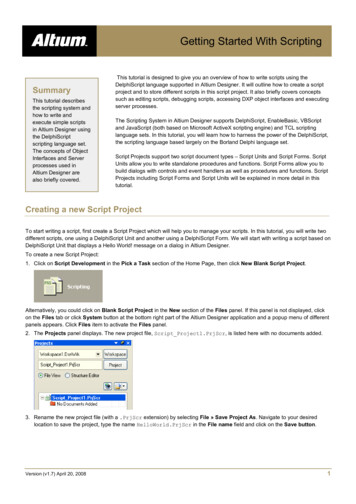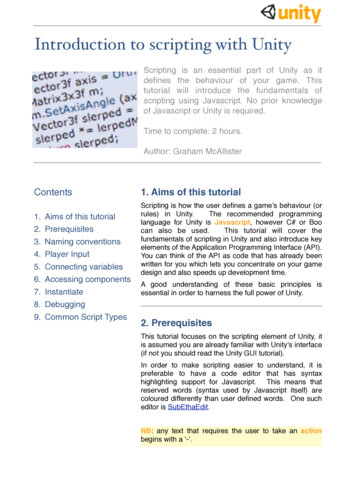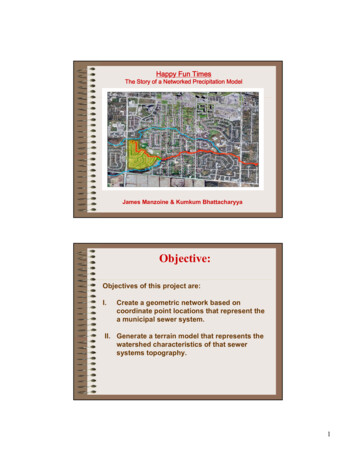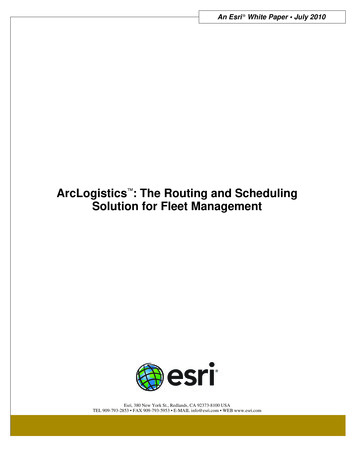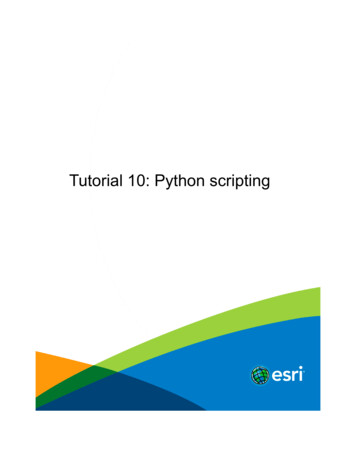
Transcription
Tutorial 10: Python scriptingCopyright 1995-2015 Esri. All rights reserved.
Tutorial 10: Python scriptingTable of ContentsTutorial 10: Python scripting. . . . . . . . . . . . . . . . . . . . . . . . . . . . . . . . . . . . . . . . .Copyright 1995-2015 Esri. All rights reserved.32
Tutorial 10: Python scriptingTutorial 10: Python scriptingDownload items Tutorial data Tutorial PDFThe Python scripting interface greatly enhances the possibilities of CityEngine. This tutorial explains the basic usage of the Pythonconsole and the editor and gives several examples on the automatization of CityEngine tasks.More information on the CityEngine-specific Python command set can be found in the CityEngine help by clicking Help HelpContents Python Scripting Reference.The Python scripting interface is not available in all CityEngine versions.Python console and editorTutorial setupTo get started, complete the following steps:Steps:1.Import the Tutorial 10 Python Scripting project into your CityEngine workspace.2.Open the Tutorial 10 Python Scripting/scenes/01 PythonScripting.cej scene.Python consoleComplete the following steps to open a new Python console:Steps:1.Open the console window by clicking Window Show Console.2.Open a Python console using the small triangle on the right side of the toolbar.Your first CityEngine Python command is a fast way to select scene elements with a specific name.Copyright 1995-2015 Esri. All rights reserved.3
Tutorial 10: Python scripting3.Type ce.setSelection.4.Press Ctrl Space to show the command completion pop-up.5.Type the ce.setSelection(ce.getObjectsFrom(ce.scene, ce.withName("*Broadway*"))) command.6.Press Enter.This selects all scene elements with names that contain the word "Broadway."Python editorAs soon as you plan to use longer and more advanced Python commands, or a set of commands, it's helpful to use the Python editorin CityEngine.Steps:1.To create a new Python script, click File New Python Module.The Python module dialog box appears.2.In the Python module dialog box, browse to the scripts folder of your project.3.Type myHelpers as the name for your new Python module.4.Select the Module:Main template.5.Click Finish.Copyright 1995-2015 Esri. All rights reserved.4
Tutorial 10: Python scriptingThe new Python module myHelpers opens in the Python editor in CityEngine.Add the new selectByAttribute(attr, value) function after the line ce CE().def selectByAttribute(attr, value):objects ce.getObjectsFrom(ce.scene)selection []for o in objects:attrvalue ce.getAttribute(o, attr)if attrvalue )Call it with specific parameters in the main clause of the script. Make sure the main block is at the end of the file.if name ' main o execute the script, click Python Run Script in the menu, or press F9 while in the Python editor.Run scripts from the consoleAlternatively, you can call your helper scripts via the Python console by completing the following steps:Steps:1.In the Python console, add the path to your module to the system path.2.Import your module. sys.path.append(ce.toFSPath("scripts")) import myHelpers3.Call your helper function in the console in the following way, with arbitrary parameters:Copyright 1995-2015 Esri. All rights reserved.5
Tutorial 10: Python d", "JUNCTION")Extend scripting.py scriptTo extend scripting.py, complete the following steps:Steps:1.Create a new file scripting.py in your CityEngine workspace using the file browser of your operating system.2.Add the following lines to automatically map your helper script at startup:import syssys.path.append({PATH TO YOUR SCRIPTS DIRECTORY})// e.g. pts")import myHelpersAfter a restart of CityEngine, your myHelpers module is loaded automatically. You can call the selection function in the console in thefollowing way: myHelpers.selectByAttribute("connectionEnd", "JUNCTION")Note: You can add arbitrary code to the scripting.py file. The startup module is executedautomatically during CityEngine startup when a new Python console is opened and a scriptis run from the Python editor.Make sure your scripting.py file is valid and executes correctly; otherwise, Pythoncode in CityEngine cannot be executed. Open a Python console in CityEngine after youcreate or modify a scripting.py file; problems with executing the scripting file aredisplayed there.scripting.py is read only once on CityEngine startup. If you modify the file, make sureto restart CityEngine.If the script is not correctly updated on CityEngine startup, delete the Python cachedirectory USER DIR/.cityengine/ CEVERSION DIR/pythonCache/.Change street widthsOften, you may want to increment the street width attribute of many segments. If this cannot be accomplished easily in the GUI, aPython script can help.Tutorial setupOpen the Tutorial 10 Python Scripting/scenes/02 PythonScripting.cej scene.Create new Python scriptSteps:1.Create a new rule file by clicking File New Python Python Module.2.Choose the project's script folder, name it setStreetWidths, and choose the Module: Main template.incrementStreetWidths() functionThis function increments the streetWidths attribute of all the selected street segments with a value specified by the user.Copyright 1995-2015 Esri. All rights reserved.6
Tutorial 10: Python scriptingFirst, the function definition:def incrementStreetWidths(increment):You need to get all selected segments and loop over them.selectedSegments ce.getObjectsFrom(ce.selection, ce.isGraphSegment)for segment in selectedSegments:To calculate the new street width, get the current value first using the ce.getAttribute() command. Note the syntax of the attributename with the prefix /ce/street/; this accesses the user attributes of the object.oldWidth ce.getAttribute(segment, "/ce/street/streetWidth")Finally, calculate the new street width by adding the user-provided parameter increment and assigning the new value to the segment.newWidth oldWidth incrementce.setAttribute(segment, "/ce/street/streetWidth", newWidth)The entire function.''' increment the street width parameter of all selected street segments'''def incrementStreetWidths(increment):selectedSegments ce.getObjectsFrom(ce.selection, ce.isGraphSegment)for segment in selectedSegments:oldWidth ce.getAttribute(segment, "streetWidth")newWidth oldWidth incrementce.setAttribute(segment, "/ce/street/streetWidth", newWidth) In the main block of the script, add the function call, and choose an increment.if name ' main ':incrementStreetWidths(10)Select a set of street segments.Run the Python script (Menu Python Run Script), or pressF9 while in the Python editor.Speed things up with @noUIupdateExecuting the previous script may take some time. This is because script execution in CityEngine runs in a separate thread andupdates the GUI and the 3D viewport after every command. In this case, after every setAttribute() call, the street network is updated,and the 3D viewport is redrawn.While this is convenient for this example, normal execution needs to be faster. This can be achieved by adding the @noUIupdatemarker above the function definition.@noUIupdatedef incrementStreetWidths(increment):Functions marked this way will block GUI update during execution but, depending on what they do, will execute faster by factors.Copyright 1995-2015 Esri. All rights reserved.7
Tutorial 10: Python scriptingCaution: Some combination of scripting commands with the @noUIupdate marker may freeze theuser interface.If you encounter a UI freeze or other unexpected behavior when using @noUIupdate, modifyyour scripts so that @noUIupdate only marks a small, specific function rather than markingyour whole script.multiplySegmentWidths() functionThis function sets several attributes at the same time, namely, streetWidth, sidewalkWidthLeft, and sidewalkWidthRight. The user canspecify a factor by which to multiply the widths.@noUIupdatedef multiplySegmentWidths(factor):selectedSegments ce.getObjectsFrom(ce.selection, ce.isGraphSegment)for segment in selectedSegments:The helper function multiplyAttribute does the multiplication for the different attributes.multiplyAttribute(segment, "/ce/street/streetWidth", factor)multiplyAttribute(segment, "/ce/street/sidewalkWidthLeft", factor)multiplyAttribute(segment, "/ce/street/sidewalkWidthRight", factor)def multiplyAttribute(object, attrname, factor):oldval ce.getAttribute(object, attrname)newval oldval*factorce.setAttribute(object, attrname, newval)multiplySegmentWidths and multiplyAttribute''' multiply street and sidewalk widths of all selected street segments by factor '''@noUIupdatedef multiplySegmentWidths(factor):selectedSegments ce.getObjectsFrom(ce.selection, ce.isGraphSegment)for segment in selectedSegments:multiplyAttribute(segment, "/ce/street/streetWidth", factor)multiplyAttribute(segment, "/ce/street/sidewalkWidthLeft", factor)multiplyAttribute(segment, "/ce/street/sidewalkWidthRight", factor)''' multiply attribute of object by factor '''def multiplyAttribute(object, attrname, factor):oldval ce.getAttribute(object, attrname)newval oldval*factorce.setAttribute(object, attrname, newval)In the main block of the script, add the function call, and choose a multiplication factor.if name ' main ':multiplySegmentWidths(1.5)Select a set of street segments.Run the Python script by clicking Python Run Script, or press F9 while in the Python editor.Copyright 1995-2015 Esri. All rights reserved.8
Tutorial 10: Python scriptingRun from consoleRather than setting the function arguments in the Python editor, the functions described above can be called from the Python consoleafter importing the script module. scriptpath mport hs(0.5)Set camera from the FBX fileThis section shows how to import static camera data into CityEngine via FBX export from Maya.Tutorial setupOpen the Tutorial 10 Python Scripting/scenes/02 PythonScripting.cej scene.Export camera to FBX (Maya)If you do not have Maya, you can skip the following steps, and use the existing data/camera.fbx file.Steps:1.In Maya, select the camera you want to export.2.Click File Export Selection.In the export dialog box, make sure the settings are set as in the following screen capture:Camera import scriptSteps:1.Create a new rule file by clicking File New Python Python Module.Copyright 1995-2015 Esri. All rights reserved.9
Tutorial 10: Python scripting2.Choose the project's script folder, name it importFBXCamera, and choose the Module: Main template.Parse the FBX fileSteps:1.Parse lines and look for ID.2.Prepare camera data in array.Nongeneric works for the specific .fbx file only.3.Parse lines from the .fbx file that stores camera data.def parseLine(lines, id):data Falsefor line in lines:if line.find(id) 0 :data line.partition(id)[2]breakif data:data data[:len(data)-1] # strip \ndata data.split(",")return datadef parseFbxCam(filename):f open(filename)lines f.readlines()cnt 0loc parseLine(lines, 'Property: "Lcl Translation", "Lcl Translation", "A ",')rot parseLine(lines, 'Property: "Lcl Rotation", "Lcl Rotation", "A ",')return [loc,rot]Set the CityEngine cameraGet the CityEngine viewport, and call the position and rotation set functions.def setCamData(data):viewport ce.getObjectsFrom(ce.get3DViews(), ce.isViewport)[0]setCamPosV(viewport, data[0])setCamRotV(viewport, data[1])def setCamPosV(v, vec):v.setCameraPosition(vec[0], vec[1], vec[2])def setCamRotV(v, vec):v.setCameraRotation(vec[0], vec[1], vec[2])Master functiondef importFbxCamera(fbxfile):data parseFbxCam(fbxfile)if(data[0] and data[1]) :setCamData(data)print "Camera set to " str(data)else:print "No camera data found in file " fileCopyright 1995-2015 Esri. All rights reserved.10
Tutorial 10: Python scriptingCall in the main blockif name ' main ':camfile ile)Run the Python script by clicking Python Run Script, or press F9 while in the Python editor.Your camera should be positioned as in the following screen capture:Note: Animation curves are not read; only the transformation camera at the frame of exportingis read.The camera needs to be exported as a single object.Animation: Grow the buildingPython scripts can be used to automate generation or export processes. The following example shows how to generate a buildinganimation by setting the building attributes and exporting the set of resulting models.Tutorial setupOpen the Tutorial 10 Python Scripting/scenes/03 PythonScripting.cej scene.Generate the buildingSteps:1.Select a lot in the scene.2.Assign the growingBuilding.cga rule file to the lot.3.To generate the building, click Shapes Generate Models.Copyright 1995-2015 Esri. All rights reserved.11
Tutorial 10: Python scriptingThe rule file includes attributes to change the dimensions of the building. Rather than manually setting these values, write a script thatchanges the values and batch generates the different versions of the model.Animation scriptCreate a new Python main module my grow building.py.def growBuildingThis function provides a time line that loops over two ranges and calls the setAttribute function.def growBuilding():for i in range(1,14):height 20 idoStep(i,height,1)for i in range(15,35):height 34width i-14doStep(i,height,width)def doStepOn the lot object, the two attributes' height and width are modified.def doStep(i,height,width):object ce.getObjectsFrom(ce.scene, , "height", "OBJECT")ce.setAttributeSource(object, "width", "OBJECT")ce.setAttribute(object, "height", height)ce.setAttribute(object, "width", width)Generate(object)def GenerateThe following generates the building:def Building is called in the main clause of the script.if name ' main ':growBuilding()Batch generate the buildingSteps:Copyright 1995-2015 Esri. All rights reserved.12
Tutorial 10: Python scripting1.Select the lot in the scene.2.Press F9 in the Python editor to run the script.Batch exportOnce you're confident with the generated models, add an additional function named Export.def Export(i, object):dir ce.toFSPath("models")file "building merge " str(i)// prepare export settingssettings settings.setOutputPath(dir)//do exportce.export(object, settings)Replace the Generate call in doStep().//Generate(object)Export(i, object)Find the exported models in the models folder. Make sure the Export function is before the main clause.Write an asset library rule fileIf you have a large number of assets, it might be helpful to look at all of them. This section shows how a CGA rule file can be generatedautomatically, which displays the project's assets.Tutorial setupOpen the Tutorial 10 Python Scripting/scenes/03 PythonScripting.cej scene.The rule file you're going to write should have the following structure:Lot -- Geometries TexturesGeometries -- set) -- i(asset)This is for the geometry assets and the texture images. Create a new Python main module my asset lib.py. Add the new function writeCGALib.def writeCGAlib():Write header information, the starting rule Lot, and the Geometries rule.cga "/*Asset Library Loader : Generated by asset lib.py*/\n version \"2011.1\"\n\n"// write start rulecga "Lot -- Geometries Textures"// write rule showing geometriescga "\n\nGeometries -- "Iterate over all .obj files in the asset folder, and prepare the rule call Geometry(assetpath) for each asset.Copyright 1995-2015 Esri. All rights reserved.13
Tutorial 10: Python scripting.// get allfor obj in// andcga .obj files from asset directory, and call their loaderce.getObjectsFrom("/", ce.isFile, ce.withName("/Tutorial 10*/assets/*.obj")):write"\n\t t(2,0,0) Geometry(\"" obj "\")"Similar rules are written for the texture assets.// write rule showing jpg texturescga "\n\nTextures-- \n\ts(1,0,0) set(scope.ty,-2) set(scope.tz,0) i(\"facades/xy-plane.obj\")"// get all .jpg files from asset directory, and call their loaderfor jpg in ce.getObjectsFrom("/", ce.isFile, ce.withName("/Tutorial 10*/assets/*.jpg")):cga "\n\tt(2,0,0) Texture(\"" jpg "\")"Write the asset loader rules.//write geometry loader rulecga "\n\n Geometry(asset) -- s(1,0,0) i(asset) set(scope.ty,0) set(scope.tz,0)"//write texture loader rulecga "\n\n Texture(asset) -- set(material.colormap, asset)"Open a file handle for the .cga file, and write the cga content.cgafile ce.toFSPath("rules/asset lib.cga")CGA open(cgafile, "w")CGA.write(cga)CGA.close()print "written file " cgafileAdd the new assignAndGenerateLib() function. It assigns the generated .cga file to a scene lot and generates the model.def assignAndGenerateLib():object ce.getObjectsFrom(ce.scene, uleFile(object, "asset lib.cga")ce.setStartRule(object, "Lot")ce.generateModels(object)Finally, call the two functions in the main clause:if name ' main ':writeCGAlib()assignAndGenerateLib()Generate the library modelIn the Python editor, with the asset lib.py file open, press F9.Automate CityEngine tasks with startup.pyYou can use python to automate larger or repetitive tasks. For example, you may want to automate model generation from parcelinformation across the county. To do this ,you would do the following:Steps:1.Create a project or use an existing one. We will use the existing Tutorial 10 Python Scripting 2018 0 tutorialproject.2.Create a Python main module in the project's scripts folder. The tutorial contains a minimal job calledautomationJob.py.3.Insert a function with the tasks for the automated job. For testing, add a call to this function in the ' main ' section.The provided fgdbToKml example imports shapes from a fileGDB to generate models and writes them out to KML:Copyright 1995-2015 Esri. All rights reserved.14
Tutorial 10: Python scriptingautomationJob.pyfrom scripting import *// get a CityEngine instancece CE()def fgdbToKml(pathFGDB,layerName,ruleName,startRule "Generate"):// open scene in the automation projectce.newFile('/scenes/emptyScene.cej')// load a databaseimportSettings r(['/' layerName])ce.importFile(ce.toFSPath(pathFGDB), importSettings)// assign rule file based on the layer namelayer ce.getObjectsFrom(ce.scene, ce.isShapeLayer, ce.withName(layerName))[0]shapes ce.getObjectsFrom(layer, ce.isShape)ce.setRuleFile(shapes, ruleName)ce.setStartRule(shapes, startRule)// export models to KMLexportSettings export(shapes, exportSettings)// close CityEnginece.waitForUIIdle()ce.closeFile()if name ' main ':fgdbToKml("data/CityData.gdb", "NewShapes", "/ESRI.lib/rules/Buildings/Building From Footprint.cga", "Generate")pass4.Create a configuration file to define the job parameters. The tutorial contains an example located in \data\jobConfig.cfg.jobConfig.cfg[config]pathFGDB data/CityData.gdblayerName NewShapesruleName /ESRI.lib/rules/Buildings/Building From Footprint.cgastartRule Generate5.Add the functions run(cfg) and getCfgValue(cfg,name) to automationJob.py in order to run the automation jobwith parameters stored int the configuration file.automationJob.py.def getCfgValue(cfg,name):for c in cfg:if c[0] name: return c[1]return Nonedef run(cfg):pathFGDB getCfgValue(cfg,'pathfgdb')layerName getCfgValue(cfg,'layername')ruleName getCfgValue(cfg,'rulename')startRule getCfgValue(cfg,'startrule')fgdbToKml(pathFGDB, layerName, ruleName, startRule)6.It is recommended to use a separate CityEngine workspace for automation. Create a new C:\Automation Workspacefolder on your system.7.Copy the /scripts/startup.py file from the tutorial project to the new C:\Automation Workspace root directory.Commands in the ' startup ' section of this Python script get automatically executed at startup of CityEngine. Thefirst startup argument defines the CityEngine project containing the automation job. It will be linked into the automationworkspace. The second argument contains the config file. It gets parsed and handed over to the automation job as a listof (name,value) pairs.After the job has finished, CityEngine get's safely shut down.Copyright 1995-2015 Esri. All rights reserved.15
Tutorial 10: Python scriptingstartup.pyfrom scripting import *from java import langimport ConfigParser, sysif name ' startup ':// get a CityEngine instancece CE()// get startup argumentsprojectFolder Path lang.System.getProperty("configFilePath")// link the automation project into automation workspaceif "automationProject" in ce.listProjects(): ect(projectFolder, False, "automationProject")// read configuration filecp cfg cp.items('config') # list of (name,value) pairs// run automation /scripts"))import automationJobautomationJob.run(cfg)// safely shut down CityEnginece.exit()8.Open the command line and start CityEngine in the automation workspace and hand over the job definition andparameters:Command Path to CityEngine.exe -data Workspace Folder -vmargs -DprojectFolder Project Folder -DconfigFilePath Configuration FilePath // Example: "C:\Program Files\Esri\CityEngine2018.0\CityEngine.exe" -data "C:\Automation Workspace" -vmargs -DprojectFolder "C:\CE Workspace\Tutorial 10 Pyth9.After the job has finished, the \models folder contains the Footprints.kmz output file shown below in ArcGIS Earth.Note: The automationJob.py file contains a minimal job, use the CityEngine Python Help totailor it to your exact needs.Copyright 1995-2015 Esri. All rights reserved.16
Export camera to FBX (Maya) If you do not have Maya, you can skip the following steps, and use the existing data/camera.fbxfile. Steps: 1. In Maya, select the camera you want to export. 2. Click File Export Selection. In the export dialog box, make sure the settings are set as in the following screen capture: Camera import script Steps: 1.


